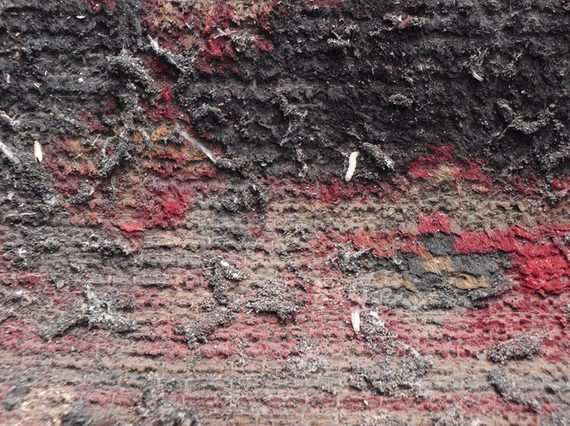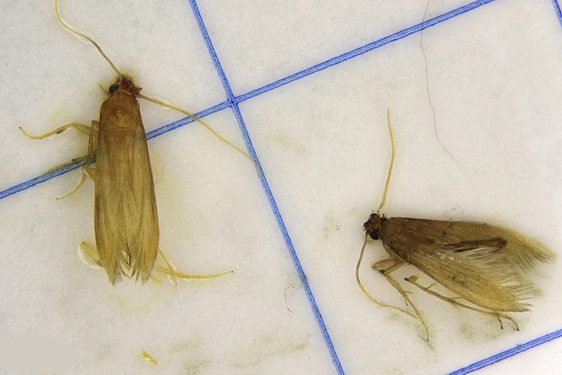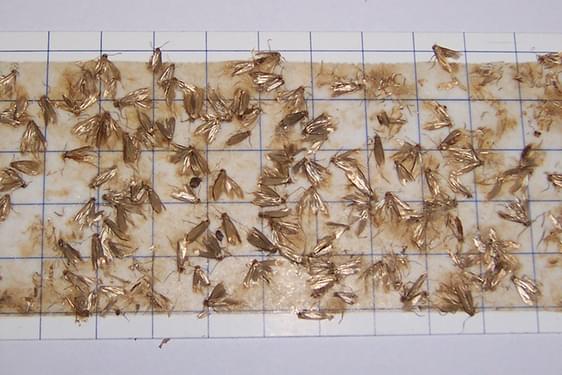
How to deal with infestation
Discovering pest species in collections can be upsetting. A good way to deal with any possible pest discoveries is to ask a number of questions about what you have found.
Identifying infestation
Firstly, is it a problem species?
You may find a large number of insects in traps and in stores. Some have no interest in eating your collections, for example spiders. The only problem they pose is being a tasty snack for some insects that may go on to eat your collection. From a housekeeping point of view we want to remove any potential food source so best to dispose of these swiftly.
Some pests may act as an indication of damp, for example woodlice (slaters). If you have lots of these it may indicate other problems with the area that could adversely affect collections. Check for water ingress, or anything that could have created a damp microclimate. It’s a good idea to routinely check buildings, and taking a bit of extra time to do this as you check pest traps gets to the heart of integrating your pest management with other aspects of collections care.
If you find a problem species, you need to determine if it is an active infestation or an historic problem. Things that may indicate an historic problem:
- There are a small number of insects on one object
- The insects may be brittle and broken up indicating they died some time ago
- There is no spread to other objects or areas of the store, other than what could have fallen from the affected object
- Furniture beetle holes look dull and may have dirt in them.
If you have a large number of insects spread throughout an area, this is more likely to indicate an active population.
It is important to determine the extent of the spread of any infestation, as treatment will need to take place in every effected area. Otherwise treated areas may easily become re-infested.
To help ascertain the spread of an insect population additional traps can be laid through the area. Consider placing them in a grid pattern to highlight any hot spots. A map of the building is helpful as it may help you consider spaces that are adjacent, that may not appear so from the ground. And don’t forget to consider the travel of pests between floors. Overlaying maps can also be useful.
The video below shows an active booklice infestation on whale bones.
Booklice infestation
This film below shows an active booklice infestation on whale bones.
Dealing with infestation
To effectively tackle an infestation there are three steps:
- Treatment of objects (those visibly infested and those that have come from infested areas)
- Treatment of the room/building
- Prevention of re-infestation
Steps to carry out these treatments:
Object treatments
We've outlined treatments below:
Low temperature
Low temperature treatment (freezing) is common in museums. A large number of materials can be treated with this method and it is effective as long as the low temperature is maintained throughout the object for the correct period of time, remembering that the core of the object may take some time to drop to the desired temperature.
Recommended temperatures
- -30°C; minimum of 72 hours maintained throughout the object
- -18°C; minimum of two weeks maintained throughout the object.
At National Museums Scotland, we generally freeze for at least 5 days at -30°C to ensure this duration is met.
Low temperature treatment is suitable for a large number of materials, however there are some exceptions which shouldn’t be frozen:
- Material under tension where different materials may contract and expand at different rates with the associated temperature changes of the freezing process, for example instruments both musical and scientific.
- Material that is made of layers particularly those that are showing signs of delaminating, for example mother of pearl and ivory, or impasto painting.
- Any material that is damp or wet, as the formation of ice crystals as it freezes may cause damage.
- Rubber and plastics. Plastics are difficult as exact composition is rarely known and the level of degradation can be varying. Some plastics may be ok to freeze, but caution should be taken.
- Velvet, where the pile may get crushed. If the pile is crushed when it is damp, it is not recoverable.
To ensure no damage occurs to the object during the freezing process items must be sealed in polythene. There is a link between the air’s temperature and its ability to hold moisture. To prevent damage by humidity change and moisture migration air volume in the package should be minimised. This can be done by wrapping the polythene as closely as possible to the objects form, and using buffering materials such as tissue to fill voids.
When wrapping objects ensure:
- You’ve mitigated against any moisture from condensation by:
- Covering metal parts with tissue
- Separating, with tissue, any textiles which may have colour that could run
- Used conservation grade materials inside the package, no sticky tape near the object!
- Completely sealed any joins in your polythene package
- Labelled the wrapped object, now its wrapped up you may not be able to see what it is!
High temperature
High temperature can be used to treat infested objects. A museum grade treatment is offered by ICM (Integrated Contamination Management) which operates in London and also has a mobile unit. A specially built chamber is heated to 52°C, while RH is maintained at a suitable level. The high temperature kills all stages of the insect lifecycle. This treatment is not suitable for all material types, for example wax, or anything that may melt, and caution should be applied if objects have undergone conservation treatment, or had lacquers or polish applied to their surface.
Other heat treatments, such as those available to de-infest mattresses, etc. are not suitable for museum objects as there is no control over RH.
Insecticide
Insecticides can come in many different forms, for example solvent based, emulsions, smoke bombs. Many of these need a pest control specialist to carry out treatment. If you employ a contractor to carry out any of these there are some points to consider:
What is the effect of the chemical that is carrying the insecticide? For example, in a solvent based solution, what is the solvent and how will this affect any objects it comes into contact with.
Are there other additives, for example perfumes or colour, that make the product smell nice for the commercial market, but are unnecessary and potentially harmful for historic objects.
How long lasting is the treatment? The time it takes for an insecticide to degrade and become ineffective will depend on its chemical make-up. Make sure that it lasts long enough, or that re-treatment is planned to capture any adults that may emerge later (furniture beetle can take up to five years to emerge). Eggs or larvae deep inside an object may not have been affected by an initial treatment.
Always seek advice from a conservator if you are looking at treating a historic object. The ICON register is a useful resource for finding conservators.
Dusts
Desiccant dusts can be used to kill insects by dehydrating them. Moisture is drawn from the insects into the dust, drying them out. This leaves the bodies of dead insects in situ, which if not cleared away, could then become a food source for other pests. These treatments should be used with caution and can be an irritant so its use must be controlled. Always follow the manufactures instructions and carry out your own risk assessment.
A dust treatment is not safe for an object, but could be considered for a space. If you are struggling to improve the environment of an area where there has been an infestation this type of treatment might be useful.
Anoxia and Carbon Dioxide
Anoxia kills by reducing the level of oxygen below a certain threshold for a period of time long enough to kill the insect by drying it out. As it tries to get more oxygen into its system moisture is lost and it desiccates.
Small scale treatments can be carried out by sealing an object with an oxygen barrier film (e.g. marvelseal) and placing oxygen scavengers (ageless) in the package. A good seal on the package (using aluminium tape) is very important or oxygen from the surrounding area will leak in. A temperature of around 22°C is also important to ensure that the insects are active enough for the treatment to work. The treatment time is around 5 weeks.
Carbon dioxide treatments must be carried out by a qualified contractor. There is a health and safety risk due to large volumes of carbon dioxide which could cause suffocation if there was to be a leak. The treatments take from 3-5 weeks and a temperature above 20°C needs to be maintained. The treatment needs to be carried out in a building which will not be accessed for the duration.
Historic treatments
Be aware that if something is tasty to pests it may have been treated in the past.
Some historic pest treatments may leave toxic residue on objects, for example treatment of taxidermy and ethnographic material. Please be aware of the history of your objects and wear suitable PPE.
Building treatment
Once the objects have been treated, they will need to be returned to display or storage. However, there is no point returning them to become re-infested. The space they came from should be treated as well. The space should be deep cleaned to remove any further insect populations, and any food source they might be feeding on. Any issues with tidiness and housekeeping should be addressed. Depending on the type of space, and scale of infestation, an insecticide treatment may be necessary.
If the RH has been high, attempts to lower this will also be beneficial as many pests do not like a drier environment. Aim to keep the RH below 60% where possible.
Preventing Re-infestation
Once you have dealt with an insect infestation you will want to do all you can to prevent its reoccurrence. Consider the IPM steps detailed throughout this training and whether you need to implement more of these in the space. We find a robust quarantine procedure and a regular schedule of cleaning post infestation works in many instances.
More sections in this training

How to identify pests
We can describe a museum pest as an animal that will in some way cause harm to museum collections.
How to prevent infestation
The best way to prevent infestation is to stop pests entering your collection.
How to monitor pests
Infestations are much easier to deal with if you catch them early.